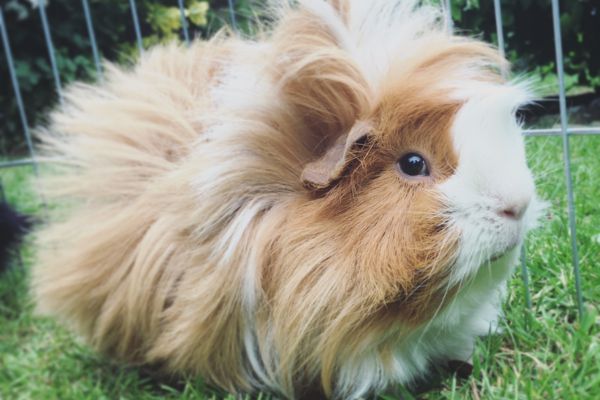The Peruvian guinea pig is one of the most popular guinea pig breeds. Its scientific name is Cavia porcellus, but it is also known as guinea pig or guinea pig. They are terrestrial animals originating from South America, especially from the region that today corresponds to Peru. It is believed that pre-Columbian peoples such as the Incas already bred these animals in captivity, both for use as food and as pets.
In recent years, the Peruvian guinea pig has gained popularity as a pet. Nowadays, these animals are popular all over the world as companion animals, being appreciated for their docile, friendly temperament and for the ease of care and feeding. He is known to be intelligent, affectionate and easy to train.

Temperamental Characteristics
The guinea pig is a herbivore animal that feeds mainly on grass, vegetables and grains. He is considered a popular pet due to his docile and sociable behavior, in addition to having:
- Body rounded and hairy, with short legs. Large eyes and small ears, weighing on average between 700 grams and 1,200 grams, have a life expectancy of about 5 to 7 years. They are social animals and like to live in groups, they have diurnal habits. They are curious animals and love to explore the environment in which they live. They communicate using a variety of sounds, such as grunts, hisses, and squeals.
- The Peruvian guinea pig is believed to have long hair as a result of artificial selection carried out by indigenous peoples of the Andes region where the species originates. For many generations, these animals were raised as a source of food and wool, used in making clothes and blankets. Through this selective selection, individuals with longer hairs were preferentially selected for breeding, leading to the development of this trait. In addition, this long coat also provides thermal protection for the species in the mountainous environment where it lives.
- Reproduction of Cavia porcellus is sexual and is quite fast, with an average gestation period of 59 to 72 days. Females can reproduce from 3-4 months of age, while males reach sexual maturity at around 3 months. Female guinea pigs can give birth to up to four piglets per litter, with an average of two or three. They can be mated again immediately after giving birth, and some females can have up to 5 litters a year.
- Cavia porcellus’ natural predators include birds of prey such as hawks and owls, as well as reptiles such as snakes. Other predators can include dogs, cats, foxes and weasels, which are wild animals that can live in urban areas. It is important to keep guinea pigs safe in a protected enclosure that gives them the possibility to hide and protect themselves from these predators. Also, it is advisable to supervise the guinea pigs during the time they are let loose.
The Differences Between the Peruvian Guinea Pig and Other Breeds
The main differences between the Peruvian guinea pig and other guinea pig breeds are their coat, size and personality.
- Coat: As mentioned earlier, the Peruvian guinea pig is known for its long, dense coat, which can reach up to 20 cm in length. Other breeds, such as the American guinea pig, have shorter, less dense fur.
- Size: The Peruvian guinea pig is considered one of the largest breeds of guinea pigs, and can weigh between 1.2 and 1.5 kg as an adult. Other breeds, such as the Sheltie guinea pig, are smaller and lighter.
- Personality: the Peruvian guinea pig is known to be a quieter and more reserved breed, they are generally more peaceful, calm and docile, preferring to stay in the tutor’s lap instead of exploring the environment. While other breeds such as Abyss guinea pigs are known to be more active and quite curious.
They like to explore their surroundings and are more likely to bite or nibble on objects within reach. However, it is important to remember that a guinea pig’s behavior can be influenced by the conditions of creation and care received since its infancy.
Necessary Care for Owning a Peruvian Guinea Pig as a Pet
To have a guinea pig as a pet, it is important to be aware of some essential care that you must take to ensure the animal’s health and well-being. Here are some of the precautions you should take:
- Shelter: Guinea pigs need a spacious, protected enclosure that allows them to move around and take shelter when needed, and that has a dry sleeping area, a place to feed, drink and relieve themselves, as well as toys and accessories to enrich the environment.
- Feeding: It is important to provide a varied and balanced diet that includes grass, quality hay, fresh fruits and vegetables, as well as guinea pig feed.
- Grooming: Guinea pigs need cleaning regularly. Due to the long and dense fur, it is necessary to brush the animal regularly to avoid the formation of knots and tangles, which can cause skin problems, discomfort and even prevent the guinea pig from moving freely. It is important to use specific brushes and combs for animals, avoiding the use of brushes for humans, as they can cause damage to the skin. In addition, care must be taken during brushing not to pull or pull the coat, which can be painful for the animal.
- Another important care is to keep the environment always clean and free of dirt or debris that could stick to the animal’s fur. It is also recommended that the owner of the animal seek the help of a veterinarian specializing in exotic animals, and if necessary, schedule a suitable haircut for the animal.
The Adoption and Protection
If you are interested in adopting a Peruvian guinea pig as a pet, it is important to consider adopting an animal from an NGO, as these animals are often abandoned. There are several NGOs that are dedicated to the protection, search in your region if there is any organization that offers adoption or that needs help in the conservation and protection of the species
Finally, the Peruvian guinea pig despite being a relatively easy animal to care for, it is necessary to ensure a healthy and safe environment for its well-being. Furthermore, it is important to remember that the reproduction of these animals is fast, which can lead to overpopulation, being vulnerable to predators in the natural environment. Therefore, more efforts are needed to protect these animals and ensure that they receive the best possible care.

